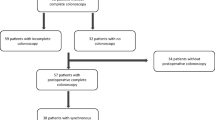Abstract
Purpose
An individual with colorectal cancer has a 3 percent risk of synchronous colonic neoplasia and further 2 to 3 percent risk of metachronous cancer, a risk that has prompted colonic surveillance. The appendix has a similar mucosal pattern to the colon and it has been hypothesized that appendicular adenocarcinoma may account for 1 percent of all colorectal malignancies. A special interest of the senior author in appendiceal and rectal cancer has prompted routine removal of the appendix in all cases undergoing surgery for colorectal cancer.
Methods
Consecutive patients undergoing left colectomy or anterior resection for colorectal cancer had coincidental appendectomy with the specimen pathologically analyzed. A retrospective review of the case notes and histopathology was performed. Data also were collected for patients who had right hemicolectomy for colonic carcinoma.
Results
In total, 169 patients under the care of a single surgeon had colorectal cancer resection between April 2002 and April 2005: 63 patients had right hemicolectomy, 29 had left hemicolectomy, and 77 had rectal cancer resection. Seven of 169 appendices had abnormalities: 3 mucinous cystadenomas, 2 cystadenocarcinomas, 1 carcinoid tumor, and 1 villous adenoma.
Conclusions
Patients having colorectal cancer resection for adenocarcinoma should have appendicectomy performed. Synchronous pathology was found in 4.1 percent in this series. Metachronous neoplasia is a risk in the retained appendix in patients with colorectal cancer. Routine postoperative surveillance cannot assess the appendiceal mucosa, so there is little justification for not taking the opportunity to eliminate the possibility of future appendicitis or neoplasia.
Similar content being viewed by others
References
Sedivy R, Wolf B, Kalipcivan M, Steger GG, Karner-Hanusch J, Mader RM. Genetic analysis of multiple synchronous lesions of colon adenoma-carcinoma sequence. Br J Cancer 2000;82:1276-2.
Heald RJ, Bussey HJ. Clinical experience of St. Mark’s Hospital with multiple synchronous cancers of the colon and rectum. Dis Colon Rectum 1975;18:6–10.
Bulow S, Svendsen LB, Mellemgaard A. Metachronous colorectal carcinoma. Br J Surg 1990;77:502-.
Deans GT, Spence RA. Neoplastic lesions of the appendix. Br J Surg 1995;82:229–306.
Nitecki SS, Wolf BG, Schlinkert R, et al. The natural history of surgically treated primary adenocarcinoma of the appendix. Ann Surg 1994;219:51-.
Mukherjee A, Parvaiz A, Cecil T, Moran B. Pseudomyxoma peritonei usually originates from the appendix. Eur J Gynaecol Oncol 2004;25:411-.
Williams RA, Meyers P, eds. Pathology of the appendix. New York: Chapman & Hall Medical, 1994:9-0
Connor SJ, Hanna GB, Frizelle FA. Appendiceal tumors: retrospective clinicopathologic analysis of appendiceal tumors from 7,970 appendectomies. Dis Colon Rectum 1998;41:75–80.
Lenriot JP, Huguier M. Adenocarcinoma of the appendix. Am J Surg 1988;155:470-.
Pettigrew RA. Carcinoma in villous appendiceal adenomata. ANZ J Surg 1980;50:627-.
Anthony T, Simmang C, Hyman N, et al. Practice parameters for the surveillance and follow-up of patients with colon and rectal cancer. Dis Colon Rectum 2004;47:807-7.
Winawer SJ, Zauber AG, Ho MN, et al. Prevention of colorectal cancer by colonoscopic polypectomy. N Engl J Med 1993;329:1977-1.
Kaibara N, Koga S, Jinnai D. Synchronous and metachronous malignancies of the colon and rectum in Japan with special reference to a coexisting early cancer. Cancer 1984;54:1870-.
Nikoloudis N, Saliangas K, Economou A, et al. Synchronous colorectal cancer. Tech Coloproctol 2004;8:S177-.
Iwuagwu OC, Jameel JK, Drew PJ, Hartley JE, Monson JR. Primary carcinoma of the appendix—Hull series. Dig Surg 2005;22:163-.
Anonymous. Gastrointestinal: synchronous and metachronous colorectal cancers. J Gastroenterol Hepatol 2003;18:457.
Warren JL, Penberthy LT, Addiss DG, Mcbean AM. Appendicectomy incidental to cholecystectomy among elderly Medicare beneficiaries. Surg Gynaecol Obstet 1993;177:233-4.
Author information
Authors and Affiliations
Corresponding author
Additional information
Reprints are not available.
About this article
Cite this article
Khan, M.N., Moran, B.J. Four Percent of Patients Undergoing Colorectal Cancer Surgery may have Synchronous Appendiceal Neoplasia. Dis Colon Rectum 50, 1856–1859 (2007). https://doi.org/10.1007/s10350-007-9033-2
Published:
Issue Date:
DOI: https://doi.org/10.1007/s10350-007-9033-2




